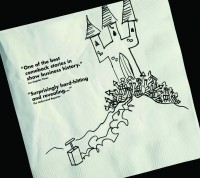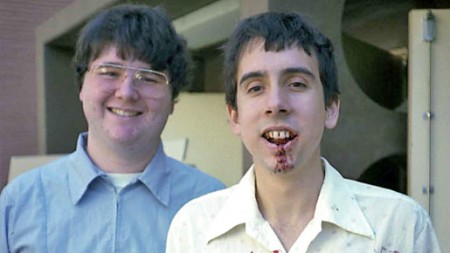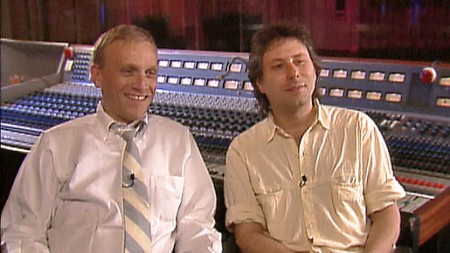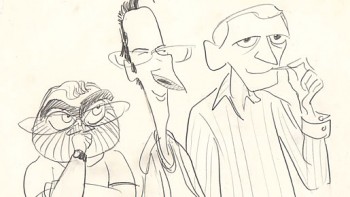Commentary &Disney 18 Mar 2010 08:39 am
Waking Sleeping Beauty
 - Waking Sleeping Beauty is a tightly edited documentary detailing the years between 1984 and 1994 at the Disney Animation Studio. From The Black Cauldron through The Lion King. There’s ample footage of the artists in meetings – particularly story meetings, goofing around and walking the halls of the old Animation building on the Disney lot.
- Waking Sleeping Beauty is a tightly edited documentary detailing the years between 1984 and 1994 at the Disney Animation Studio. From The Black Cauldron through The Lion King. There’s ample footage of the artists in meetings – particularly story meetings, goofing around and walking the halls of the old Animation building on the Disney lot.
Yet the story being told – without an iota of fat – is the story of the above-the-line players and how they felt about each other. The machinations and power plays they work on each other to wrest control and credit for the studio’s success is the primary interest of this film, not the attitudes and thoughts of the animation people.
Only a couple of times do we really get to imagine how the artists felt about what was going on. There’s a meeting called by Katzenberg to talk about how the people felt about the period. They explained that they weren’t able to spend appropriate time with their families because of all the excess overtime that was demanded of them. Katzenberg tears up and promises that things will get better. They don’t; things get worse.
Throughout the film is colored with home movie footage taken by Randy Cartwright of a lot of the animators and artists mugging for the camera. The only shot that gives an inkling that something serious is going on is a shot where Tim Burton is caught at his drawing board, and he literally doesn’t know what to do. Frustration, irritation and annoyance beams off his face. It was one of the biggest laughs for the audience surrounding me. There are ample and tight closeups of many of these people: Tom Sito, Andreas Deja, Eric Goldberg, Joe Ranft, Roger Allers, Mike Gabriel and many more. Yet, none of them – NONE – are labelled and identified.

Joe Ranft and Tim Burton still don’t recieve identification in this film.
Yet their images are known by many outside the industry.
Yet, every executive gets clear identification. Even the full list of end credits runs alongside running footage of people/artists in the studio saying hello and playing for the camera. Yet, none of these people are identified. I’m not even sure their names appeared in the credits since it was hard to watch the running type while trying to see the archival footage.
Despite this complaint, the story told was engrossing. Since I can identify most of the people, I was also absorbing every frame of the home movies and the footage shot for PR sake that also filled the film.

Howard Ashman and Alan Menken are given the due credit for both The Little Mermaid and Beauty and the Beast and, to some extent, Aladdin. Ashman, as we know, had a lot to do with the shaping of both films. I’d already given credit to him for much of the guidance of the two films, so it was good to see the filmmakers support this. In many ways, in my mind, a great deal of credit for this renaissance fell on his shoulders.
 In fact, I’m surprised, given the enormous success the studio has had over the years with Alan Menken’s songs and music, that they didn’t bring him in for The Princess and the Frog. Menken brought good luck to so many of the animated features of this period that one wonders if it may have helped. Given his successful track record, there was more likelihood that he might have brought something to the film. They were trying to reboot their musical franchises, yet they turned to Randy Newman – who’d been hit and miss for them at Pixar. Perhaps the Pixar connection gave Newman the upper hand with John Lasseter, probably finalizing that decision.
In fact, I’m surprised, given the enormous success the studio has had over the years with Alan Menken’s songs and music, that they didn’t bring him in for The Princess and the Frog. Menken brought good luck to so many of the animated features of this period that one wonders if it may have helped. Given his successful track record, there was more likelihood that he might have brought something to the film. They were trying to reboot their musical franchises, yet they turned to Randy Newman – who’d been hit and miss for them at Pixar. Perhaps the Pixar connection gave Newman the upper hand with John Lasseter, probably finalizing that decision.
The film includes newly recorded interviews with many of the higher salaried artists which overlapped some of the footage and helped to move the story. Eisner, Katzenberg or Roy Disney are also seen in detailed comments taken from press releases, all of which underlines the lust for power over the animation studio. The fever pitched competition between Disney and Katzenberg is certainly highlighted.
Don Hahn directs the film with assuredness, and he acts as the primary narrator – though, producer, Peter Schneider‘s high-pitched comments certainly color the film as well.
It’s a tense and serious attempt to record a POV of one very successful period at the Disney studio, and to a great extent they get it. However, since it is made by two people in a position of power, their interest is definitely focussed on the four people above them – Eisner, Disney, Katzenberg and Wells. To be honest, I’m not sure the drama would have held if you’d concentrated on the people below their level. However, I do think the artists deserve at least to have been identified.
It’s a very entertaining film for those interested in animation and Disney, in particular.
The film opens in four cities on March 26th: NY, LA, SF and Chi. You can see it at the Landmark Sunshine theater in NY.

on 18 Mar 2010 at 8:52 am 1.Mark Mayerson said …
I haven’t seen the film, so I can’t comment on specifics. However, the truth is that there would have been no animation renaissance without the baby boomer generation of artists who grew up watching older animation on TV and were desperate for the opportunity to do similar work.
The renewal of American animation bubbled up from the bottom. It was not created from the top. Executives may have guided it, but they’re the ones who eventually destroyed it.
Someday I hope to see a triple bill of Waking Sleeping Beauty, The Sweatbox and Dream on Silly Dreamer. I suspect all three are needed to give a rounded view of what happened.
on 18 Mar 2010 at 9:00 am 2.Dave Levy said …
The close up of Tim Burton caught unaware at his drawing board got the big laugh at the SVA screening as well, but I didn’t read into it all that you did. What I saw was a young man at work and suddenly someone puts a camera in his face. His slack jawed and dazed expression got a laugh, but I don’t assume the rest of the narrative you assign here.
I agree that the drama in the film would not have held the same power if they concentrated on the artists’ side. But, for us animation folk, that would still make for an interesting film.
on 18 Mar 2010 at 9:05 am 3.Michael said …
All I would have liked is a simple on-screen identification of the artists who made the studio and the film at the time.
on 18 Mar 2010 at 9:10 am 4.Dave Levy said …
That was curiously lacking. You would assume that the filmmakers would have at least identified the top level animation talent.. especially those like Tim Burton that went on to be such powerhouses later. It only would have enhanced the story to do so. The danger in not doing so is that it makes the animation talent seem interchangeable with individuals not making important singular contributions.
on 18 Mar 2010 at 10:20 am 5.Richard said …
The real problem with this film is the makers tip-toe around a LOT of bodies. Granted, they quickly narrow the focus of the film on the massive egos of Eisner and Katzemburg–with some Roy Disney tossed in.
They ignore the contributions of people like John Musker and Ron Clements, who almost single handedly saved the studio with films like Basil/Great Mouse Detective and The Little Mermaid. I doubt the latter would have been as great without Ashmen, but the idea was Musker/Clements, and they fought to bring Ashman on board.
The film makers also completely ignore their own complicity on the political red tape of the studio and it’s eventual downfall. They take the “I wash my hands of it” attitude which is off-putting, and frankly, insulting to artists everywhere. It also makes them out as complete fools.
It’s not a COMPLETE whitewash, but the real story of Disney animation will have to wait until next year, when a book on the studio from the day Walt diedto the downfall of Eisner comes out.
BTW, half of the super-8 footage was shot by John Lasseter, days before he was fired from the studio.
on 18 Mar 2010 at 11:50 am 6.anonymous said …
I can only speak for my own experience at Disney during that time, but it seemed that everyone complained about Jeffrey until Peter Schneider came along. Then we complained about Peter until Tom Schumacher came along. Finally it got worse than anyone could have EVER imagined under David Stainton.
Somewhere along the line we all missed Jeffrey.
on 18 Mar 2010 at 12:40 pm 7.Alisa said …
I was also surprised at the lack of labeling the artists’ names. It seemed very hit or miss as to who got identified. Since the directors mentioned key people like Joe Ranft in their opening statements, (and he was among those the film was in memory of) I was shocked that they never even identified him on screen.
This era of animation is very much the reason for my interest in becoming an animator but I’d say I was only able to identify about a third of the artists shown in the film. Most animators know the big names like Glen Keane, Andreas Deja, Tim Burton, Don Bluth, Tom Sito, etc but there are always so many people behind the scenes who were probably ill-credited to begin with. Ultimately, it felt as though the producers viewed the artists as eye candy to lighten up the otherwise power-play heavy plot.
My boyfriend, a non-animator, enjoyed the film but in the end questioned who Waking Sleeping Beauty’s target audience is. I have a feeling the main audience in years to come will be animation history classes.
on 18 Mar 2010 at 12:45 pm 8.Michael said …
Anonymous, your telling of the overlord story is pretty much the version I culled from all the years of watching and listening to what’s been said by the workers and gossips I’d heard. I was hoping some of the picture would have been clarified by the flm but realized immediately that wouldn’t happen.
on 18 Mar 2010 at 1:14 pm 9.Richard said …
The film makers at Disney were pushed and prodded by Katzenburg, and they were on equal footing to push back. And they did. The “ying” and “yang” made it work best.
When Katzenburg got fired, the situation fell apart. Neither Disney nor Katzenburg has done their best work since–Disney because they began overmanaging things, and smothering the goose, and Jeffery because he’s surrounded by sycophants.
What’s not been so well documented is the fascinating story of the studio in the ’70′s. The upcoming book will “tell all,” from Bluth’s pettiness (and how the older Disney animators couldn’t stand him), to the hiring and subsequent firing of some of the best talent under their noses.
And Alisa, you’re correct. This film aims at slightly wider audience than that “Dream On” film (which is not terribly good on any account). But not much.
“The Sweatbox” is VERY egocentric (sting), but is a far better document than either of these films.
on 19 Mar 2010 at 9:21 am 10.nw said …
I saw this film at the Tiff festival here in Toronto last year ( Don Hahn was in attendance) I found it really enjoyable. It gave us a glimpse into what the studio was like during this time.
on 19 Mar 2010 at 2:43 pm 11.Floyd Norman said …
For better or worse, the public has never had any interest in animation artists. I felt that director, Don Hahn was wise to focus on his “stars,” Disney, Eisner and Katzenberg. They drove the compelling narrative.
Since I was part of this incredible story, I laughed and I cried throughout the film. This is what a good movie should be.
on 21 Mar 2010 at 4:18 pm 12.Jenny said …
I haven’t seen it yet.
That said, while you’re right in your assessment, Floyd, it would likely have been possible via skillful filmmaking to *make* the public a bit more informed and hopefully interested in the animation artists involved.
What I mean is, while I understand the apparent intent and reason for the particular focus, I also believe it could have been done differently. Obviously I’d always want to make sure via voiceover or caption who is who when it comes to Joe Ranft and Tim Burton-and Randy Cartwright and Mike Gabriel and everyone else who was there as an artist.